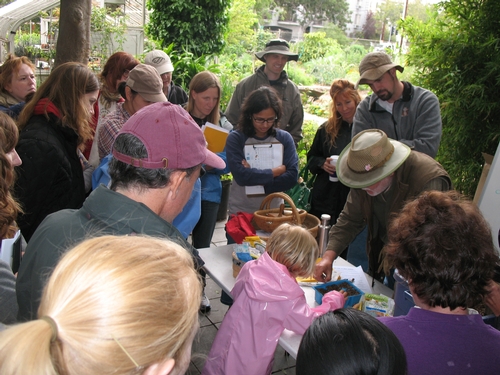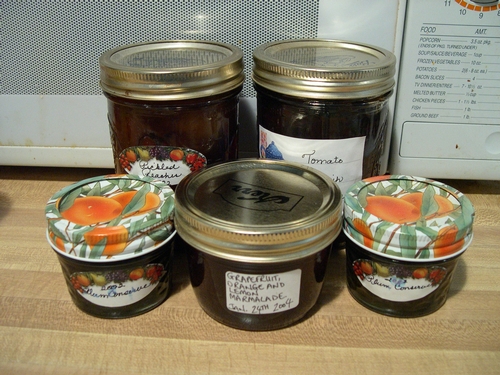UC Blogs
Now That's Italian!
Now that's Italian! The Italian honey bee (below) nectaring on a zinnia at the University of California, Davis, is striking for two reasons: she's...
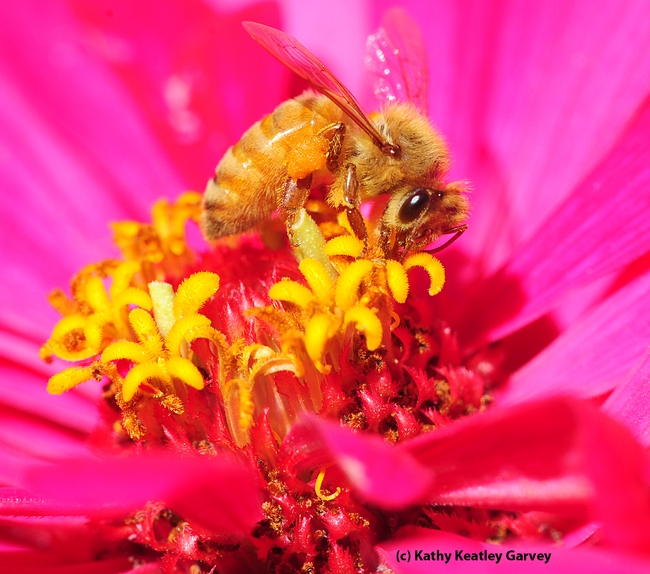
Italian honey bee forages on a zinnia. (Photo by Kathy Keatley Garvey)
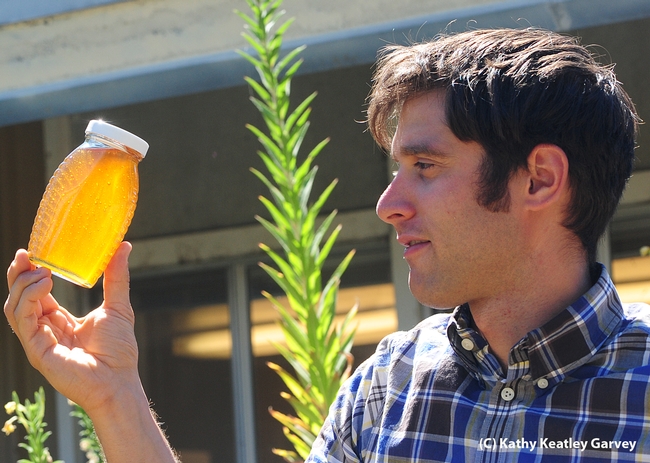
UC Davis staff research associate/beekeeper Billy Synk admires a freshly bottled jar of honey to the sun. (Photo by Kathy Keatley Garvey)
Sample Garden
Everybody likes a deal, especially if that deal is FREE, or almost free! Gardeners and Master Gardeners are no different. In fact this Master Gardener has had to watch out for a few flying elbows at the occasional event when someone has uttered those words “come and get it!” There are deals to be had that you don’t have to risk life and limb. There are giveaways by companies, organizations, and your neighbor if you just take a look around.
Some of the easiest ones to pick up are items are that are “one man’s junk”, for lack of a better word. Both major coffee/tea chains freely give away their used grounds for soil amendment. These are usually kept in a particular place that is easily accessible. If there are none in the bin that day, keep checking back.
Some companies or agencies want you to sign up for their e-newsletter to receive something. The recent one I found was for California Native Seeds at http://www.applyresponsibly.org/ . You take a water wise quiz and at the end enter your information to be sent your seed packets.
Newspaper makes great “landscape fabric”. We’ve been putting it down as a layer before we put down our growing medium for a few years now. For us, it seems to work just as well or better than any we would buy. Just be sure to use a newspaper that uses soy based ink like the San Francisco Chronicle. Unwaxed broken up cardboard boxes work well as a weed block too, or just to plain get rid of the weeds. Be sure to weight these down if they aren’t going under topsoil right away.
Wood chips for garden mulch or even decorative purposes can be had from many arborists. The arborist that cut down some poorly placed trees was more than happy to leave the chipped wood with us and even said he’d be glad to drop some more by if he was in the neighborhood and we needed more.
Garden Supply Company has a pretty good free vegetable garden planner. You can choose the size of your garden by square feet and then either choose a pre-planned garden from their selection, or you can create your own. It seems like that base it on the square foot garden design. You can even change the name of the vegetables if you’d like say to Patti’s Parsnips, or fill in the names of all the different varieties of tomatoes you’ve planted this year. They even allow you to email it to yourself (or your gardener if you’re say Martha Stewart and have one on staff). It will include planting and care directions for those you’ve chosen. http://www.gardeners.com/Kitchen-Garden-Planner/kgp_home,default,pg.html?SC=XNET9009
There is a plethora of goods out there for the gardener to be had for basically nothing, so go and get it, and hopefully you’ll be able to avoid injury.
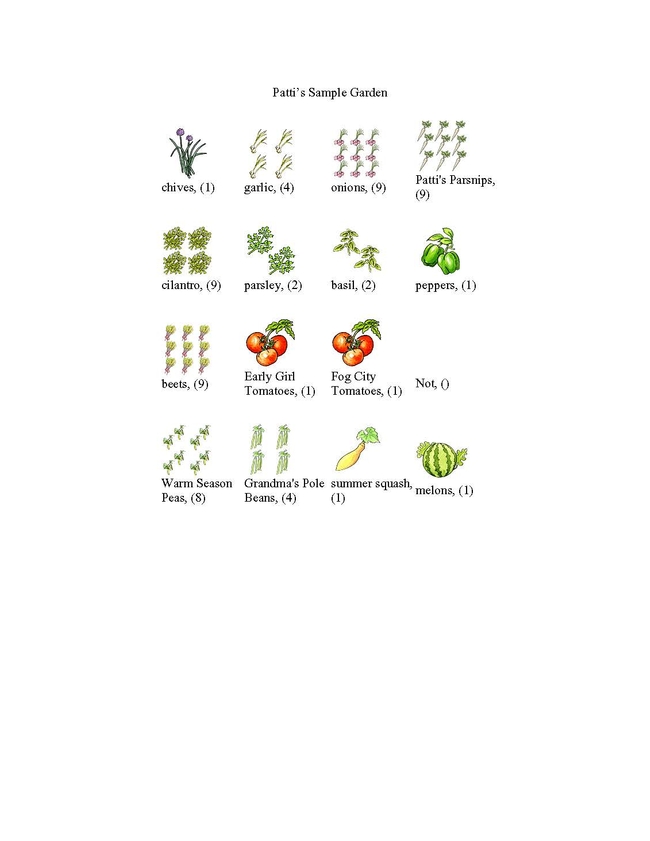
Patti's Sample Garden.
Master Gardeners and Master Food Preservers at the LA County Fair!
Do you wonder why your tomatoes are so tiny or why there are so few? Do you wonder when to start lettuce seeds so you can harvest throughout the winter to avoid the high prices at the stores? Maybe, you're not sure when to prune your roses for lots of color next year. Well, the Los Angeles County Master Gardeners can help you. Trained by the experts from the University of California and having had many years of gardening experience, they know the answers to the challenges gardeners face.
You can chat with Master Gardeners in person at the LA County Fair (in the Flower and Garden Building) on Saturdays and Sundays in September from 11 am to 9 pm.
Throughout the year, you can call the Master Gardener Helpline at (323) 260-3238 to leave a message. Or you can email your question with a photograph of your gardening problem to mglosangeleshelpline@ucdavis.edu. Master Gardener volunteers will respond within three days.
The Los Angeles County Master Food Preservers will also be at the fair. Learn how to pickle and make jellies and jams. They will be conducting demonstrations on two stages: The Culinary Styles Stage (under the racetrack grandstand) and the Farm House Kitchen (at FairView Farms across from the Big Red Barn).
A special feature will be a giant solar dehydrator on display at FairView Gardens from 9 am to 12 pm on Wednesdays through Fridays.
To contact the Master Food Preservers Program and request volunteers, email mfpla@ucdavis.edu.
The mission of the Los Angeles County Master Gardeners and Master Food Preservers is to train volunteers to teach low-resource communities how to grow and eat more fruits and vegetables, preserve the excess from their gardens, and employ food safety practices at home.
For more information, please visit the Master Gardener Volunteer Training Program and the Master Food Preserver Program. To find out more about UC Cooperative Extension in Los Angeles County, please visit our website.
Climate change fuels western wildfires
From California’s Ponderosa fire to Colorado’s record-breaking Waldo Canyon fire and other blazes burning across the West, the summer of 2012 -- like many recent summers -- has been marked by a long, intense wildfire season. It has claimed thousands of acres, hundreds of homes, and in some cases, lives.
Malcolm North, professor in the Department of Forest Ecology at UC Davis and U.S. Forest Service research scientist, studies the effects of fire on Sierra Nevada coniferous forests. In this video, North explains how climate change and a history of fuel suppression in the forest mean wildfires will burn hotter, faster, longer and more often -- indefinitely.
“I believe very strongly we’re going to have more fires, larger fires, and those fires are going to be of higher severity,” he says. “We do need to figure out a means of making the forest more resilient.”
North is principal investigator on the Teakettle Ecosystem Experiment, which is looking at the effects of fires and forest thinning on a forest ecosystem.
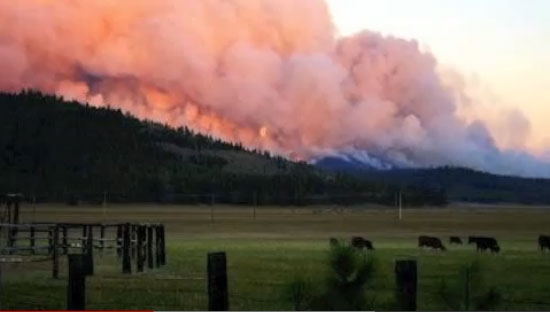
The Moonlight Fire of 2007, which burned about 70,000 acres, is an example of a high-intensity fire.
The Red Mush
It's that time of year again, when the freeway on and off ramps are bordered by vivid red mush. The mush consists of flattened tomatoes that have rolled off the trucks as they enter and exit the main roads. Tomatoes are Solano County's number one crop. Earlier in the month my husband Keith and I decided to follow some tomato trucks near Pedrick Rd to see where they were going. We trailed them to the Campbell processing plant. It was impressive to see truck after truck pull in, wait in lines, and then upend their cargo into waiting containers.
On the home front, the tomatoes had a pretty slow start with our cooler than average first half of summer. Mine didn't particularly seem to appreciate the week of 100 degree temperatures that followed. Now however, they seem to be doing better and I have a lot more ripening fruit. Each year I like to try a few new varieties along with my tried and true. This year one of my newbies seems to be doing best of all. I found it at the San Francisco Flower and Garden Show. I hadn't heard a thing about it and picked it on its name alone. It's called ‘Solano Gold’. It's gold with green streaks until it is fully ripe when it turns completely golden. It's tasty and on the smaller size. It looks great mixed in with other tomatoes of different colors in a salad.

Truckloads of tomatoes in Dixon. (photos by Keith Arrol)
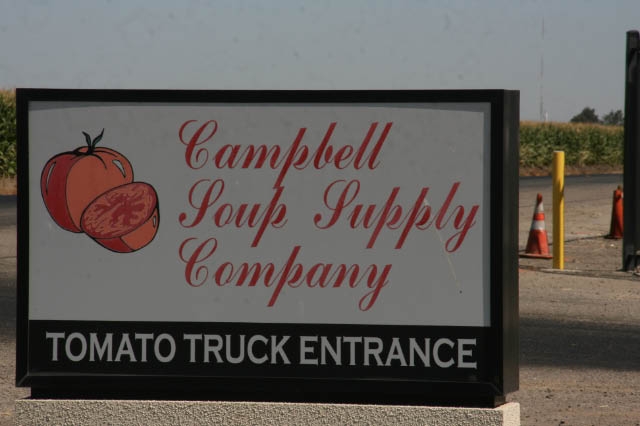
Campbell's.

Tomatoes in the field.


